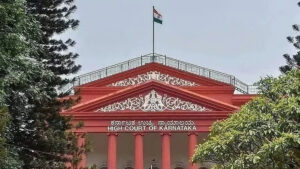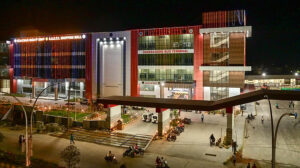Mumbai, India’s bustling financial capital, made history by recording its wettest May in over a century, with 295 mm of rainfall drenching the city in a single day. This deluge, driven by an unusually early southwest monsoon, broke a 107-year-old record set in 1918, transforming the city’s streets into rivers and bringing daily life to a near standstill. From waterlogged roads and disrupted public transport to flooded tech parks and stranded commuters, the rains tested Mumbai’s resilience while highlighting its vulnerability to extreme weather. This blog explores the causes of this historic downpour, its impacts on the city, the response from authorities, and the broader implications for Mumbai’s future in an era of climate change.
A Record-Breaking Deluge
The India Meteorological Department (IMD) announced that the southwest monsoon arrived in Mumbai on May 26, 2025, a staggering 16 days earlier than its typical June 11 onset, marking the earliest monsoon advancement in the city since 2001. By the end of the day, the Colaba observatory had recorded 295 mm of rainfall, surpassing the 1918 record and cementing May 2025 as Mumbai’s wettest in 107 years. Social media posts on X captured the intensity, with one user reporting a cloudburst-like 100 mm of rain in just one hour between 9 a.m. and 10 a.m. at Nariman Point, underscoring the ferocity of the downpour.
The early monsoon was driven by a potent combination of atmospheric conditions: a low-pressure system over the Bay of Bengal, a north-south trough extending across central India, and high moisture retention in the atmosphere. These factors fueled thunderstorms and gusty winds, with speeds reaching 45–55 km/h, battering Mumbai and the coastal Konkan belt. The IMD issued red alerts for eight weather stations, including Borivali, Santacruz, Powai, Mulund, Chembur, Worli, Colaba, and Alibag, while orange alerts covered Navi Mumbai, Thane, and Kalyan. The forecast warned of continued heavy to very heavy rainfall, with isolated areas potentially seeing “extremely heavy” showers.
This wasn’t Mumbai’s first brush with record-breaking rains. In July 2005, the city faced a catastrophic deluge, with 944 mm of rain in a single day, claiming over 400 lives. More recently, July 2024 saw 300 mm of rainfall overnight, flooding railway tracks and prompting the adjournment of the Maharashtra legislature. The May 2025 event, however, stands out for its timing and intensity, occurring in a month typically associated with pre-monsoon showers rather than full-scale monsoon chaos.
The Impact: A City Submerged
The torrential rains brought Mumbai to its knees, disrupting every facet of daily life. Low-lying areas like Dadar, Mahim, Parel, Bandra, and Kalachowki were inundated, with waterlogging reported across major roads, underpasses, and railway tracks. The Sion-Kurla and Chunabhatti areas saw severe flooding, affecting the Harbour Line’s suburban train services, while the Central Line faced delays due to water on the tracks at Nahur. Western Railway services were delayed by up to 15 minutes, leaving commuters stranded during peak hours. Social media posts on X painted a grim picture, with visuals of waterlogged tracks at Wadala and GTB stations and commuters wading through knee-deep water.
The city’s tech hubs, including Bandra-Kurla Complex (BKC) and Andheri, were hit hard, with flooded offices disrupting operations for thousands of professionals. Mumbai’s airports faced chaos, with flights diverted due to low visibility and waterlogged runways. The Brihanmumbai Municipal Corporation (BMC) reported no “major” waterlogging, a claim met with skepticism by residents who shared images of submerged vehicles and traffic jams stretching for miles. One X user described the city as “paralyzed,” with bridges at Dadar, Prabhadevi, and Lower Parel completely jammed.
The human toll was significant. While no fatalities were reported on May 26, the rains claimed three lives earlier in the month during a similar downpour, highlighting the recurring dangers of Mumbai’s monsoon. Over 500 homes were flooded, displacing families and damaging property. Lakes like Powai, with a capacity of 545 crore liters, teetered on the edge of overflow, raising concerns about potential breaches. The BMC’s disaster management teams worked tirelessly to pump water from low-lying areas, but the scale of the deluge overwhelmed even their best efforts.
A City’s Struggle with Infrastructure
Mumbai’s record-breaking rainfall exposed deep-rooted infrastructure challenges. The city’s drainage system, largely a colonial-era relic, struggles to cope with heavy rains, particularly when combined with high tides in the Arabian Sea. On May 26, a high tide of 3.78 meters at 10:03 a.m. exacerbated flooding in coastal areas, a phenomenon Deputy Chief Minister Devendra Fadnavis noted as a key factor in Mumbai’s inundation. Encroachment on wetlands and mangroves, coupled with unchecked urbanization, has reduced the city’s natural drainage capacity, turning even moderate rains into urban disasters.
The BMC has faced criticism for inadequate pre-monsoon preparedness, despite spending crores on drain desilting and flood mitigation. In July 2024, Congress leader Vijay Wadettiwar slammed the civic body’s efforts after 300 mm of rain disrupted the Maharashtra legislature, a sentiment echoed by residents in 2025. Posts on X highlighted waterlogged areas like Hindmata and Parel, with users urging authorities to prioritize infrastructure upgrades. The collapse of a section of National Highway 66 earlier in May, attributed to poor construction, further fueled public frustration with the state’s readiness for extreme weather.
Mumbai’s history of rain-related tragedies—such as the 2005 floods, the 2017 Elphinstone stampede, and the 2024 hoarding collapse—underscores the stakes. The 2005 deluge, which paralyzed the city and caused widespread loss of life, remains a cautionary tale. Recent incidents, like the July 2024 flooding that led to a child’s death in a nullah, highlight the human cost of unpreparedness. The May 2025 rains, while less deadly, serve as a reminder that Mumbai’s infrastructure must evolve to match its growing population and changing climate.
The Response: Resilience Amid Chaos
The BMC, police, and disaster management agencies sprang into action, deploying teams to clear debris, pump water, and assist stranded residents. The National Disaster Response Force (NDRF) was mobilized in Mumbai and neighboring areas like Thane, Palghar, and Raigad, where heavy rains also caused disruptions. Deputy Chief Minister Devendra Fadnavis, monitoring the situation, reported that 374 people were rescued and shifted to safer locations in Sindhudurg, which recorded 216.5 mm of rain. The BMC’s claim of no major waterlogging was met with skepticism, but its efforts to keep bus routes operational and deploy pumps in low-lying areas showed a commitment to mitigating the crisis.
Chief Minister Eknath Shinde urged residents to avoid non-essential travel, a directive echoed from previous floods in 2023 and 2024. Schools and colleges in Mumbai, Ratnagiri, and Sindhudurg were closed as a precaution, a decision announced by School Education Minister Deepak Kesarkar in the state legislative council. The IMD’s red and orange alerts kept authorities on high alert, with forecasts of continued thunderstorms prompting round-the-clock monitoring. Community resilience shone through, with residents sharing food, water, and real-time updates on X, helping each other navigate the chaos.
Climate Change and Mumbai’s Future
The record-breaking rains of May 2025 are part of a broader pattern of intensifying weather events in Mumbai. The city has seen multiple records shattered in recent years: July 2024’s 300 mm overnight deluge, September 2023’s return of rains after a lull, and now May 2025’s historic 295 mm. The IMD attributes these events to climate change, which is increasing the frequency and intensity of monsoons in coastal regions. The early onset of the 2025 monsoon, covering not just Mumbai but also Bengaluru, Karnataka, and parts of Andhra Pradesh and Telangana, signals a shift in India’s weather patterns.
Mumbai’s geography—sandwiched between the Arabian Sea and the Western Ghats—makes it particularly vulnerable to heavy rainfall. Urbanization has exacerbated this, with concretized surfaces and encroached water bodies reducing natural drainage. The city’s 1,800 km of stormwater drains, many over a century old, are ill-equipped for cloudburst-like events, as seen in the 100 mm hourly downpour at Nariman Point. Experts argue that Mumbai needs a comprehensive overhaul of its drainage system, alongside measures like mangrove restoration and lake preservation, to mitigate future floods.
The state government has proposed ambitious projects, such as a water grid to address droughts in Marathwada and water transfer from Konkan to the Godavari basin. However, these long-term plans must be paired with immediate action to address urban flooding. Deputy Chief Minister Fadnavis’s acknowledgment of high tide-related flooding highlights the need for integrated coastal management, while public calls on X for better drainage and stricter regulations on construction reflect growing demand for accountability.
Lessons from the Past, Hopes for the Future
Mumbai’s history is intertwined with its monsoons, from the ancient ports of Puri-Konkan described in historical records to the modern metropolis of today. The Maharashtra State Gazetteers note that the region’s coastal geography has always shaped its fortunes, from trade to tragedy. The May 2025 deluge is a modern chapter in this saga, a reminder that Mumbai’s growth must be tempered with resilience. Past floods, like those in 2005 and 2024, have spurred incremental improvements, but the scale of the challenge demands bold action.
The city’s tech industry, a global powerhouse, faces disruptions with each major rain event, threatening Mumbai’s reputation as a financial hub. Small businesses, daily wage workers, and marginalized communities bear the brunt, with flooded markets and homes disrupting livelihoods. Yet, Mumbai’s spirit remains unbroken. The outpouring of community support, from volunteers aiding stranded commuters to social media updates guiding travelers, reflects the city’s resilience—a quality that has defined it through centuries of challenges.
Looking ahead, Mumbai must invest in climate-smart infrastructure: modernized drains, elevated roads, and restored wetlands. The BMC’s ongoing desilting efforts and the state’s disaster management framework are steps in the right direction, but they must be scaled up. Public-private partnerships, leveraging Mumbai’s tech expertise, could drive innovations like real-time flood monitoring and smart urban planning. The IMD’s new weather model, mentioned in X posts, offers hope for better forecasting, potentially reducing the impact of future deluges.
A City Forged by Rain
Mumbai’s record-breaking May 2025 rainfall is both a milestone and a warning. The 295 mm downpour, shattering a century-old record, celebrates the city’s enduring relationship with the monsoon while exposing its vulnerabilities. As the rains continue, with the IMD forecasting more showers, Mumbai stands at a crossroads. By learning from this deluge and investing in resilience, the city can ensure that its future is defined not by flooding but by its ability to thrive amidst nature’s fury.
The images of waterlogged streets and stranded commuters will fade, but the lessons of May 26, 2025, must endure. Mumbai, with its indomitable spirit and global ambitions, has the opportunity to lead as a model for urban resilience. As the monsoon continues to shape its destiny, the city’s response to this historic deluge will determine whether it emerges stronger, ready to face the storms of tomorrow.
Sponsored
FACTS Transcripts
Apply for a University document anywhere
https://www.factstranscript.com
Quick Transcripts for popular Universities, check your University name now and get started. We help you to get your transcript application online which is accepted for use of IRCC.
No DD, NO Paperwork. 100% Authentic, Reliable.
FACTS Transcripts Charges · Reviews · Assam Universities · Home · Know your University









